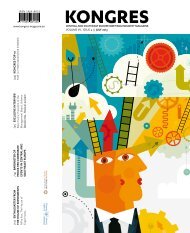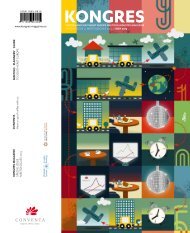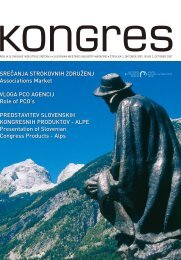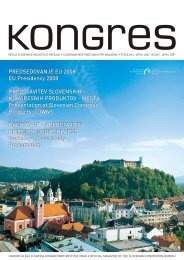EIBTM 2008 Industry Trends & Market Share Report - HCB
EIBTM 2008 Industry Trends & Market Share Report - HCB
EIBTM 2008 Industry Trends & Market Share Report - HCB
You also want an ePaper? Increase the reach of your titles
YUMPU automatically turns print PDFs into web optimized ePapers that Google loves.
November 2001. Consumers were more pessimistic about unemployment in the next<br />
12 months than at any time since October 2005.<br />
Nevertheless, the economic context is not uniformly bleak, throughout the world. A<br />
very different situation is to be found in the BRIC economies (Brazil, Russia, India<br />
and China). While these countries are widely forecast to experience some slowdown<br />
in their growth rates, this is not expected to be as severe as is expected in the US<br />
and Europe. It has been predicted that Indian economic growth will fall from 9<br />
percent to 7 percent in 2009, and that Chinese growth will fall from 10 percent to 8<br />
percent (FT 30/10/08)(2). However, it is clear that these are still extremely high<br />
expansion rates, characterising nations that are enjoying healthy levels of growth. As<br />
a consequence of its continuing economic expansion, China is set to overtake the US<br />
next year as the world’s largest producer of manufactured goods, four years earlier<br />
than expected, according to forecasts by Global Insight, for the Financial Times.<br />
According to their estimates, next year China will account for 17% of the world’s<br />
manufacturing output, compared with 16% for the US. In 1990, before economic<br />
reforms began to work, China accounted for a mere 3% of global manufacturing (FT<br />
11/08/08)(1).<br />
The Middle East’s economy is also widely regarded as being somewhat immune to<br />
the world slump, with GDP growth in that region expected to run at an average<br />
7.5% between now and 2012 (Sunday Times, 31/08/08). However, this prediction<br />
could be scuppered by the steep fall in the price of oil. By October, falls in Gulf Arab<br />
markets had hit developers and banks in the region hardest, with governments<br />
hoping that huge budget surpluses and non-oil sector growth would sustain them<br />
through the crisis. However, more positively, some analysts maintain that the current<br />
meltdown could bring a much-needed cooling of the overheated economies in the<br />
region (Guardian 11/10/08).<br />
THE TECHNOLOGICAL CONTEXT<br />
A survey conducted prior to the Hospitality Sales and <strong>Market</strong>ing Association<br />
International's (HSMAI) <strong>2008</strong> Affordable Meetings National and Event Technology<br />
Expo in Washington DC revealed that planners are noticing a significant increase in<br />
the amount of technology used for meetings, big and small. 57.5 percent of meeting<br />
and event planners said they were incorporating technology into their meetings with<br />
the use of online registration. That particular use of technology was followed by<br />
video conferencing (used by 20.4 percent of respondents), social networks (17.7<br />
percent) and blogs (14.2 percent). Other meeting and event planners mentioned<br />
their increasing use of electronic surveys, cyber cafes, and podcasts.<br />
However, the MPI FutureWatch <strong>2008</strong> <strong>Report</strong> concluded that technology developers<br />
have some way to go in satisfying the expectations of the increasingly sophisticated<br />
market of meeting professionals.<br />
4








